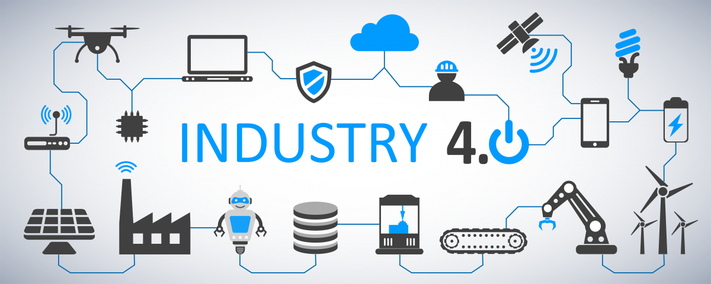Industry 4.0 is also known as the fourth industrial revolution. It is the term used to refer to the changes in the working or happenings in the value chain process of any industry. Those changes are concerned and occur due to changes in the technologies, managing all standard process within the manufacturing industry like development, production, logistics, etc. and offering better ways to organise and manage the working of the industry.

The first industrial revolution was concerned with mechanization through water and steam power. The second was concerned with mass production and assembly lines using electricity. The third is concerned with the adoption of computers and automation. Finally, the fourth revolution of the industry is concerned with the enhancement of the third revolution with smart and autonomous systems of data and machine learning.
Read Also:
- How to See Someone Whatsapp in Your Phone
- 12 Best Website Builder to Build A Free Website or Online Store
The new digital system of Industry 4.0 sources includes:
- Industrial IoT devices;
- Robotics tools and autonomous robots;
- Big Data analytics systems;
- AI and Cognitive systems;
- Augmented Reality.
The main difference from the previous stage is that it connects physical with digital technologies and allows for better collaboration and access across departments, partners, vendors, products, and people. This leads to an increase in the productivity of the industry.
Contents
Challenges in Adopting Industry 4.0
The challenges faced by industries to convert into the 4.0 industry is tough. Currently, most manufacturers agree that the implementation barriers are so strong that they managed to achieve only a little progress with their Industry 4.0 initiatives during the past year.
There are various challenges which the industry faces while its transformation into the 4.0 industry. Detailed information is the key to make your journey of Industry 4.0 easy. As for many company owners Industry 4.0 is an unknown subject but Infopulse has made it easy by explaining everything about it in detailed manner.

What are the Top Challenges:
- Lack of unified leadership which makes the working of employees difficult and leads to cross-unit coordination difficult within the company.
- When choosing third-party vendors for hosting and operationalizing company data leads to data ownership.
- Lack of courage on the part of the industry to launch the radical digitalization plan.
- Lack of in-house talent to support the development and deployment of Industry 4.0 initiatives, which plays a major role in the transformation.
- Difficulties to enable initial connectivity which is caused due to lack of contact and coordination among the coordinators and other employees
Coordinators and employees do not have enough knowledge about technologies, vendors, and IT outsourcing partners that play an important role in making an initiative to the transformation of the industry. The challenge of product digitalization and automation in the industry.
4 Best Qualities of Industry 4.0
1. Vertical Networking
Vertical Networking is one of the main characteristics of Industry 4.0. Due to various changes that come as a result of the shift in demand, unexpected equipment faults, and stock levels, manufactures are responding to it. This is because of the digital to physical processes that take place in the working of the industry. In smart industries, different systems are connected with one another, which makes it the highly connected entities.
2. Horizontal Integration Via A New Generation of Global Value Chain Networks
A higher level of transparency is present in the working of the industry 4.o due to the Physical Digital Physical (PDP) loops. With the help of this factor, companies can locate and respond to problems faster. With the help of a wide network of the organization, it enables it to record information from all the operations, including intralogistics and warehousing, to prototyping and production, to marketing and sales to downstream services. Each and every work and process of the industry is logged and can be assessed and analyzed whenever needed.
3. Through-Engineering Across the Entire Value Chain
All the product development that occurs in the industry and manufacturing activities are integrated and coordinated with the product life cycles. New interaction and collaboration emerge between product development and production systems of the 4.0 industry.
4. Acceleration Through Exponential Technologies
The main use of Industry 4.0 is to create an increasingly autonomous and highly cognitive ecosystem. This widely depends on technologies such as machine learning, deep learning, advanced robotics, and industrial IoT to further accelerate efficiency.
Also Read: Office 365 Backup Services
4 Best Benefits of Industry 4.0
The industries tend to get various benefits for the adoption of Industry 4.0. The technologies used under Industry 4.0 can entirely transform the chain value of the industry by manufacturing more and more products. This adoption of Industry 4.0 not only increases productivity, but it also leads to innovative products and service deployment, which is one of the most important benefits of Industry 4.0.
1. Revenue gains
According to a PwC report, the European countries’ adoption of Industry 4.0 with digitized products and services have added billions of additional revenue per year. Similarly, Trailblazing companies with digitized products and services have seen above-average growth in the past three years. With the adoption of Industry 4.0, it has been seen that the company’s revenue increases with a double-digit.

This adoption also leads to an increase in the sale of digitized products. With the help pf, this adoption company is also able to understand customer needs and preferences. The new insights can be applied to product development and used to increase customer interactions.
2. Increased Efficiency and Productivity
With the adoption of Industry 4.0 has not only lead to a digitized product, but Industry 4.0 also causes an increase in efficiency and productivity. This adoption has already been deployed by companies like Airbus, Cisco, Siemens, and a number of other leaders in the Industry 4.0 space. Businesses can now create more advanced IoT ecosystems of gadgets developed by different vendors, as the protocol enables transparent, fast, and secure connectivity all over the world and data exchanges between different IIoT systems.
Human-robot teams are also playing a major role in increasing productivity and efficiency. New-gen robots can help manufacturers in the parts of the production processes and speed up time-to-market. This increases the sale as well as covers the demand quickly. MIT estimates that collaboration with robots can reduce workers’ idle time by 85%.
Australia’s Drake Trailers, a company that recently added a welding robot to its production line, reported a 60% increase in productivity among their staff. Cornell Dubilier, one of the largest power capacitor manufacturers in North America, managed to double their speed of labeling process from 125 parts an hour to 250 parts an hour with the help of a robot that works with the team to increase the sale and productivity.
The task of labeling and inspections was now done by Baxter, which earlier used to be a manual. This has now led to a decrease in the wastage of time. With the help of Baxter, the company was able to increase the productivity of the digitized product on a huge scale.
3. Machine Downtime Reductions
Predictive maintenance in Industry 4.0 can identify any kind of failure before it occurs in the industry. ML-powered systems can spot repetitive patterns that precede failures, notify your teams, which can further take the relevant initiative to solve an issue. Such system are also capable of spotting even more granular changes and helping the company to continuously optimize their production process.
Deloitte Estimates That Predictive Maintenance Can:
- Reduce maintenance planning time by 20-50%.
- Diminish total maintenance costs by 5–10%.
- Increase equipment uptime and availability by 10–20%.
Technicians of the company now can conduct in smart glasses, design or produce real-time data about necessary service or repair points. With the help of this device, the manufacturer can deliver instant instructions, checklists, and 3D models to compare to actual equipment.
- Boeing reduced the time required for wiring by 25% and slashed error rates to zero.
- GE Aviation improved MRO efficiency by nearly 10%.
Read Also:
4. Improved Supply/Demand Matching
Inventory Management that is increasing in supply by managing demand enable better interactions with suppliers. Instead of operating with the individual, you can create transparent exchanges around the world and ensure that you have:
- High service-parts fill rates;
- High levels of product uptime with minimal risk;
- Higher customer service levels.
By pairing your inventory management system with a big data analytics solution, you can improve your demand forecasts by at least 85%. All the manufacturing sector is basically at the edge or corner of the great transformation into the digital world. In order to increase the productivity and sale, the industries are adopting 4.0 industry methods, and it can only be done depending upon the knowledge about the new technologies and use cases– an explore how they can fit your new strategic initiatives.






![DNS_Probe_Finished_No_Internet Error [RESOLVED] Fix DNS_Probe_Finished_No_Internet Error](https://howandwow.info/wp-content/uploads/2019/09/Fix-DNS_Probe_Finished_No_Internet-Error.jpg)
![Err_Connection_Reset Error in Chrome [RESOLVED] Fix Err_Connection_Reset Error in Google Chrome](https://howandwow.info/wp-content/uploads/2019/09/Fix-Err_Connection_Reset-Error-in-Google-Chrome.jpg)
![Err_Cache_Miss in Google Chrome Error [RESOLVED] Err_Cache_Miss in Google Chrome Error](https://howandwow.info/wp-content/uploads/2019/08/How-to-Fix-Confirm-Form-Resubmission-Error.jpg)





![Steam Missing File Privileges Error [RESOLVED] How to Fix Steam Missing File Privileges](https://howandwow.info/wp-content/uploads/2020/07/How-to-Fix-Steam-Missing-File-Privileges-Error-100x70.jpg)





![SIM Not Provisioned MM#2 Error [RESOLVED] SIM Not Provisioned MM#2](https://howandwow.info/wp-content/uploads/2020/03/SIM-Not-Provisioned-MM2.jpg)







